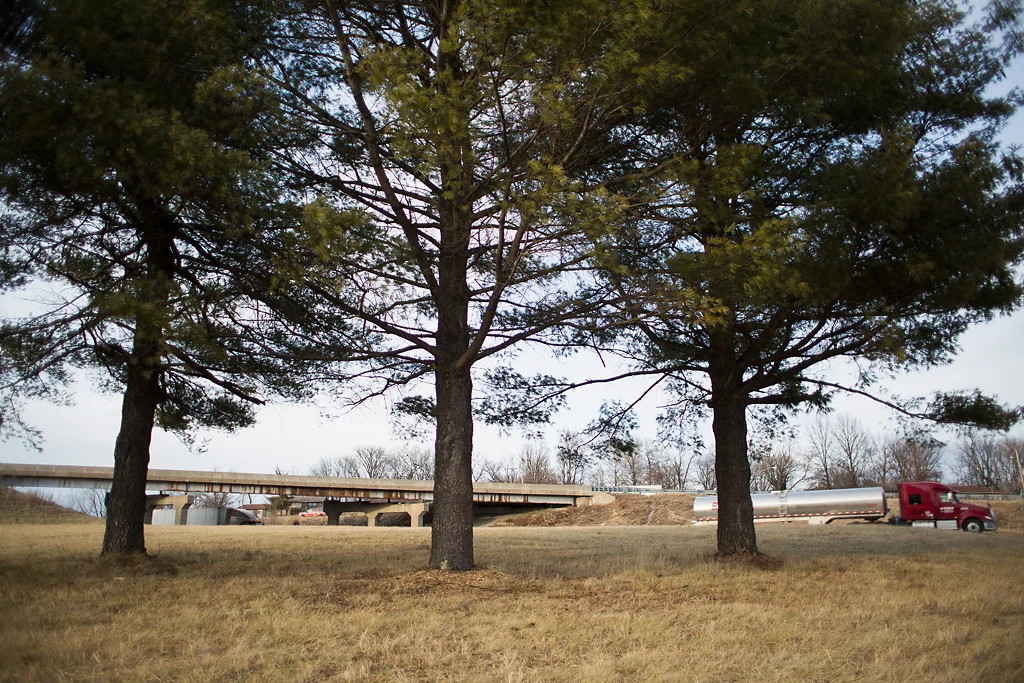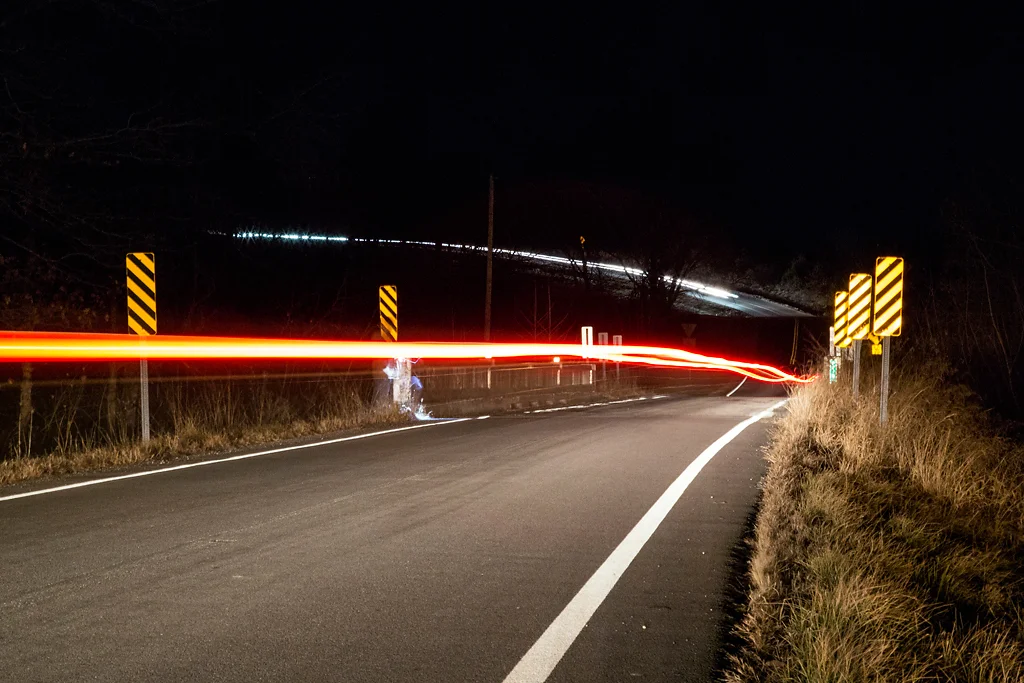Bridges of Boone County
By Hannah Sturtecky and Luke Brodarick | Published by the Columbia Missourian
As Missouri bridges and roads deteriorate, funding for repairs is nowhere in sight
By Dylan Jackson
COLUMBIA — A small bridge spans Coon Creek, a shallow waterway flanked by a row of trees on either bank, painting a dense wall of foliage through the flat, rural hillside a couple miles north of Harrisburg.
Known as bridge P0384 by the Missouri Department of Transportation, or MoDOT, the 64-year-old bridge has been deemed "poor" by the Federal Highway Administration, meaning the bridge is "structurally deficient."
In this case, water, salt and chloride have seeped into the concrete over time, weakening the deck and threatening the bridge substructure.
While MoDOT insists that all open bridges are safe, poor bridges need more frequent inspections and maintenance, and they must eventually be replaced.
MoDOT engineers can't gauge how much longer a bridge has, or how soon until it must be closed. But they do know the bridge and hundreds of others like it, mostly in rural areas, may have to last many more years before they are replaced.
Danny and Kathy Stidham live north of the bridge over Coon Creek, in a modest two-story house in front of a wide expanse of rolling hills. The couple recently married, and Danny Stidham makes a living raising livestock and cultivating crops on their property north of Harrisburg, a sleepy town of 271.
Their crowded front yard mirrors his profession — a grain truck, tractor, sedan, two pick-ups and assorted machines inhabit the lawn like industrial yard ornaments.
The land was once his grandfather's, he said, passed down in his family since the Homestead Acts over 100 years ago.
Stidham often drives across the bridge for work — baling hay and working nearly 140 acres on the other side of the creek. If the bridge failed inspection and was closed by MoDOT, his alternatives range from 5-to-20 miles.
"If that bridge closed, I'm sure MoDOT would quickly replace it." he said cheerfully. "Just last year, they repaved the road in front of our house."
Unfortunately, Bob Brendel, a spokesman for MoDOT, doesn't share Stidham's optimism. Years of funding cuts, shrinking revenue and increased traffic have severely limited the department's ability to replace damaged bridges.
"The truth is, at our current funding levels, we're just treading water," Brendel said. "For every poor bridge we replace, another one goes out of commission."
Of the nearly 10,400 bridges in Missouri, about 860 have been deemed poor, and 60 percent of the state's bridges have exceeded their original lifespans.
There are 10 poor bridges in Boone County alone, many in rural areas.
Most rural bridges are used only a few hundred times each day, while those closer to cities may see tens of thousands of vehicles. In a tight budget, priorities must be made, and smaller, less-traveled bridges don't often make the list according to Alan Trampe,* a MoDOT bridge engineer.
State roads like Route F, which snakes through northern Boone County, are also victims of the tight budget. Most state roads are two-lane and lack shoulders. A slight swerve off the narrow road can land a vehicle in a ditch.
Stidham is fully aware of the potential danger of these roads. Whenever he drives his tractor down Route F, he enlists the help of his wife to ensure that he maneuvers his equipment safely.
"Kathy hops in the truck and drives ahead of me waving a bright towel out the window," he said, looking over to her and grinning. "That's the best way we've found to make sure people pay attention and don't run off the road."
'We're doing everything we can'
Since 2014, former Gov. Jay Nixon cut nearly $34 million from MoDOT's budget, including $20 million that eliminated the cost-sharing program established to help match funds with local governments to undertake public work projects. The project is important to local governments across the state, and a top priority to planning organizations like the Mid-Missouri Regional Planning Commission that work with MoDOT and local municipalities to identify high-priority infrastructure needs.
Gov. Eric Greitens' proposed FY 2018 budget has not restored this program.
But much like Missouri's roads and bridges, MoDOT's biggest funding problems stem from the inevitable passage of time, according to Mike Schupp, a central district engineer for MoDOT.
"Inflation has reduced the purchasing power of Missouri's 17-cent gas tax by 50 percent" since 1996, Schupp said. Additionally, because cars are more fuel efficient, the department brings in less funding even as more people use the roads, he said.
"We're doing everything we can," Schupp said.
In 2011, MoDOT responded to low funding with what it called "MoDOT's Bolder Five-Year Direction," a move that placed new emphasis on maintenance instead of new construction, while reducing the department's $1.2 billion construction budget to $600 million.
Over the subsequent five years, the department cut 1,200 employees, shuttered 124 buildings and sold 752 pieces of equipment.
County commissioners, MoDOT engineers and other planning organizations agree that increased funding is the only long-term solution to fix Missouri's aging infrastructure.
MoDOT estimates the costs of all high-priority needs for the state's infrastructure to come in at $825 million.
It would cost $170 million to improve minor road conditions and fix Missouri's poor bridges alone, $275 million to improve safety — the addition of road shoulders, extra lanes and rumble strips — $300 million for highway reconstruction, and another $80 million for railroad, waterway and port improvements.
Response from the Capitol
The Missouri legislature has wrestled with funding options for MoDOT for years — the most high-profile attempt being a 5.9-cent gas tax increase proposed by Rep. Doug Libla R-Poplar Bluff, last year.
The tax found bipartisan support, drawing endorsements from many Republicans and former Gov. Nixon, as well as outside groups such as the Columbia Chamber of Commerce. Pro-business, conservative and traditionally anti-tax, the Chamber saw the raise as necessary to attract businesses to Missouri.
In the end, the Missouri House couldn't stomach a tax increase, and after passing in the Senate, 21 to 10, the bill died in the House.
As of now, no major transportation funding bills are in the works, though MoDOT's struggles are well known throughout Jefferson City.
Rep. Chuck Basye, R-Rocheport, is open to voting for a gas tax. His district encompasses much of rural Boone County, including the bridge that Danny and Kathy Stidham rely on.
"I'm not a fan of raising taxes," Basye said. "But I see this as a necessity."
Rep. Scott Fitzpatrick, R-Shell Knob, is the chairman of the House Budget Committee. He favors tying the 17-cent gas tax to inflation, which he said is a better long-term option for MoDOT funding.
"I like the idea of the gas tax. The more you use the roads, the more you have to pay," Fitzpatrick said. "If you have the tax tied to the rise of the cost of materials and labor over the years, you won't have to keep passing tax raise after tax raise."
Fitzpatrick, though, said he won't sponsor such a tax bill this year. Because of federal funding received by MoDOT, he said infrastructure problems are a long-term issue, not an immediate one.
In 2015, former-President Barack Obama signed the Fixing America's Surface Transportation Act, which provided federal highway funding to state governments. The federal money — totaling $973 million in FY 2018 for Missouri — must be matched by the state at the rate of 1 to 4 and comprises nearly 40 percent of MoDOT's budget.
In 2016, MoDOT nearly lost the money. Lack of revenue meant that the department could not meet the match required to receive the funds. MoDOT found a solution by dipping into finite cash reserves, which will continue for the foreseeable future.
Greitens has repeatedly emphasized opposition to any tax increase this session, and he has been relatively quiet about transportation since his inauguration.
While the governor's FY 2018 budget released last week recommends appropriating more money to the department than Nixon's last budget, it was less than what was requested, and it won't help the state make much progress on reducing the backlog of projects.
"Transportation is often taken for granted," Brendel said. "It's like flipping a light-switch and expecting that every time, the light will come one. One day, it won't."










